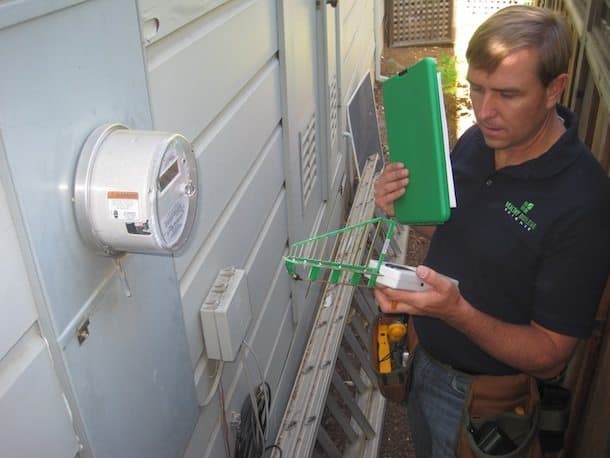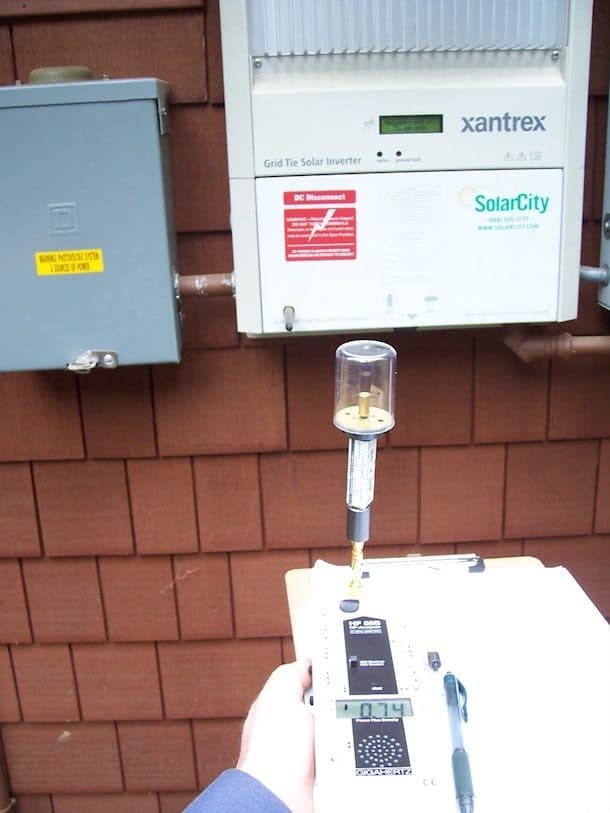BY HEALTHYBUILDING / THURSDAY, 30 MAY 2013 / PUBLISHED IN ENVIRONMENTAL TESTING, HEALTHY BUILDING INSPECTIONS & TESTING
How to Measure EMF: The Art of Knowing What You Are Studying
There are a lot of people concerned about electromagnetic fields (EMF) and electromagnetic radiation (EMR or also known as radio frequency (RF)). People want to know how to measure EMF. So much so, that they purchase detectors and meters for themselves and attempt to study their own property and homes. It is great to take responsibility for your own concerns! However, there are likely many things that could be confusing your personal emf testing and rf testing assessments.
The electromagnetic spectrum is organized by frequency. Generally, lower frequency radiation is on the left, and higher frequency radiation is on the right. See the above graphic.
The properties of electromagnetism change at different frequencies and electric and magnetic fields behave differently along the spectrum. A material that is transparent to visible light can be opaque to infrared light, but then again transparent to radio frequency radiation (e.g., glass). Chrome is highly reflective to all of these frequencies, but nearly invisible to IR cameras because it reflects much more heat energy than it emits. So how do you measure the temperature of a chromed device if you cannot attach temperature sensors (thermocouples) to it?

EMF Meter Should Detect Hot Spots – Magnetic Fields Near Electrical Panel. [Measuring 157 milliGauss (mG)]
Measuring Magnetic Fields
Meters measuring magnetic fields strength analyze the flux (changing field properties) of the magnetic field. A meter in motion will not measure this accurately, because measurements will be artificially elevated as you move through a magnetic field. While an accurate quantitative measurement cannot be made while moving, a qualitative measurement can be made to show places where more investigation is recommended. Walking through a building with a magnetic field meter taking real-time measurements is still an effective strategy of finding “hot spots.”
Measuring Radio Frequency (RF) Radiation
Higher than expected radio frequency (RF) power density can be just as confusing. RF can act sort of like X-rays, penetrating through many materials, reflecting off others. This can produce apparently high power densities in certain areas and make finding the source of those RF radiations more difficult. Using separate RF meters or antennas with the capability of omnidirectional AND more focused targeting can be useful in RF testing.
If you find areas that raise your concerns it is best to refer to an expert in the field – much like a medical generalist refers to a specialist. A qualified EMF specialist is trained specifically in the use of high-quality equipment, has area-specific knowledge, and has experience with many different buildings and situations.
EMF Testing Services
If you bring your EMF concerns to Healthy Building Science, it usually makes our jobs easier by giving us a heads-up as to where to start our investigation and EMF testing. Don’t be surprised if our investigation brings unforeseen conclusions! Often we deliver better than expected news and peace of mind, and no additional measures are recommended or the fix is more simple than you think.
Healthy Building Science is an environmental consulting firm which provides EMF testing, emf surveys, emf consultations and RF testing for the greater San Francisco Bay Area and all of Northern California.
TAGGED UNDER: ELECTROMAGNETIC RADIATION (EMF), HEALTHY BUILDING CONSULTING
https://healthybuildingscience.com/2013/05/30/how-to-measure-emf/
August 8, 2018

EMF emissions are generated by a myriad of electrical components, transmission equipment, machines and consumer electronics. Since these sources operate on a wide range of frequencies, finding a meter to measure all of them can be a daunting task.
This is why EMF meters, expensive as many of them are, should be regarded as a must-have survival tool for some people (though not everyone), much like one would use a docimeter when traveling through Fukushima or Chernobyl today. Certainly, if you plan to implement shielding solutions to block EMF radiation, or relocate your wireless devices and appliances, an EMF meter is necessary to test whether these strategies work, have no effect at all, or actually worsen your exposure. Fortunately, EMF meters tailored for consumer use are now available, and if you do homework you can usually find a good one at an affordable price.
Even though the better models come with a steep learning curve, these devices will help you identify hidden sources of non-ionizing radiation, both inside your house and several blocks away. Not only that, you'll be able to measure the strength of an EMF emission at various distances. That way you can determine the extent of any potential harm.
And once you've identified the danger zones where strong EMF's are exceeding the safe exposure limits, you can brainstorm the best form of mitigation.
Of course, understanding EMF meter technology can be a search-and-rescue mission in itself. As you wade into its deep, nerdy waters, you'll discover a convoluted universe of techy terminology, poorly written user guides (some even leave out instructions for how to use the meter), and a price range that belongs in the Guinness Book of Records. A meter can be had for as cheaply as $32, or as costly as $2,700. So before you click the "Buy" button at an EMF safety store online, better cool your heels and take the time to learn all you can about these products.

The Electromagnetic Spectrum, part of which is shown above, divides various electrical applications according to the number of waves they generate per second, otherwise known as frequencies. The measuring unit of frequency is the hertz, and one hertz equals one complete wave.
For starters, there isn't just one type of radiation to measure, but three. Each focuses on a distinct type of physics and uses different measuring units to gauge the strength of an EMF:
____
Best EMF Meters to Measure Home & Wireless Radiation
August 8, 2018
A comprehensive tutorial and buyers guide with product reviews, prices and other advice on choosing the right EMF meter. Includes recommended exposure limits and links to manufacturers.
While your eyes may furnish the best (and cheapest) gauge for detecting sources of harmful EMF's around you, increasingly those sources are being hidden from view. Cell phone towers now sport a variety of different disguises in urban areas, while smaller-scale "minicells" look like ordinary electric boxes mounted on utility poles. Banks of Smart meters may be cloistered on the backside of apartment complexes or lurking behind locked doors on the first floor of your workplace. And inside your home, potent magnetic fields emanating from walls and appliances have been linked to leukemia for the past forty years. Consequently, you never really know anymore when you're walking into an electromagnetic minefield.

EMF emissions are generated by a myriad of electrical components, transmission equipment, machines and consumer electronics. Since these sources operate on a wide range of frequencies, finding a meter to measure all of them can be a daunting task.
This is why EMF meters, expensive as many of them are, should be regarded as a must-have survival tool for some people (though not everyone), much like one would use a docimeter when traveling through Fukushima or Chernobyl today. Certainly, if you plan to implement shielding solutions to block EMF radiation, or relocate your wireless devices and appliances, an EMF meter is necessary to test whether these strategies work, have no effect at all, or actually worsen your exposure. Fortunately, EMF meters tailored for consumer use are now available, and if you do homework you can usually find a good one at an affordable price.
Even though the better models come with a steep learning curve, these devices will help you identify hidden sources of non-ionizing radiation, both inside your house and several blocks away. Not only that, you'll be able to measure the strength of an EMF emission at various distances. That way you can determine the extent of any potential harm.
And once you've identified the danger zones where strong EMF's are exceeding the safe exposure limits, you can brainstorm the best form of mitigation.
Of course, understanding EMF meter technology can be a search-and-rescue mission in itself. As you wade into its deep, nerdy waters, you'll discover a convoluted universe of techy terminology, poorly written user guides (some even leave out instructions for how to use the meter), and a price range that belongs in the Guinness Book of Records. A meter can be had for as cheaply as $32, or as costly as $2,700. So before you click the "Buy" button at an EMF safety store online, better cool your heels and take the time to learn all you can about these products.

The Electromagnetic Spectrum, part of which is shown above, divides various electrical applications according to the number of waves they generate per second, otherwise known as frequencies. The measuring unit of frequency is the hertz, and one hertz equals one complete wave.
For starters, there isn't just one type of radiation to measure, but three. Each focuses on a distinct type of physics and uses different measuring units to gauge the strength of an EMF:
- Magnetic fields are found around all powered-on appliances, electrical components, home wiring and basically every device or largescale installation that's hooked up to utility power, a generator or batteries. These fields are measured with a magnetic field meter or gauss meter, with operating frequencies in the lowest range of the electromagnetic spectrum, typically 3 hertz to 2000 hertz. Around your home, school or office, you'll find most magnetic fields oscillating in the 50-60 hertz range of the power grid.
Magnetism is measured in units of gauss or teslas.
Electric fields are generated by voltage. Voltage functions sort of like water pressure in your plumbing. Even when electronic devices and appliances are turned off, it persists, so long as the power connection is energized at the source and the equipment is plugged in. Electric trains, grid power lines and utility substations all generate potent electric fields that may be harmful. An electric field meter measures this type of EMF in units of volts per meter.
Radiofrequency (RF) radiation is emitted by radio and TV broadcasting antennas, cell phones and towers, computer equipment, Smart meters, radar and the myriad of other wireless products and equipment operating at freqencies between 3 kilohertz to 300 gigahertz.
An RF or HF (high frequency) meter measures these traveling microwaves, most often in watts or volts per meter.














Ei kommentteja:
Lähetä kommentti
You are welcome to show your opinion here!